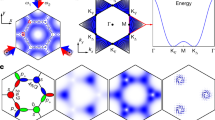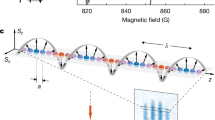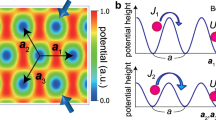Abstract
Quantum antiferromagnets are of broad interest in condensed-matter physics as they provide a platform for studying exotic many-body states1 including spin liquids2 and high-temperature superconductors3. Here we report on the creation of a one-dimensional Heisenberg antiferromagnet with ultracold bosons. In a two-component Bose–Hubbard system, we switch the sign of the spin-exchange interaction and realize the isotropic antiferromagnetic Heisenberg model in an extended 70-site chain. Starting from a low-entropy Néel-ordered state, we use optimized adiabatic passage to approach the bosonic antiferromagnet. We demonstrate the establishment of antiferromagnetism by probing the evolution of staggered magnetization and spin correlations of the system. Compared with condensed-matter systems, ultracold gases in optical lattices can be microscopically engineered and measured, offering remarkable advantages for exploring bosonic magnetism and spin dynamics4.
This is a preview of subscription content, access via your institution
Access options
Access Nature and 54 other Nature Portfolio journals
Get Nature+, our best-value online-access subscription
$29.99 / 30 days
cancel any time
Subscribe to this journal
Receive 12 print issues and online access
$209.00 per year
only $17.42 per issue
Buy this article
- Purchase on Springer Link
- Instant access to full article PDF
Prices may be subject to local taxes which are calculated during checkout




Similar content being viewed by others
Data availability
Source data are provided with this paper. Data for figures that support the current study are available at https://doi.org/10.7910/DVN/GPMPMP.
Code availability
Numerical simulations were performed with Python code that makes use of the OpenMPS Library available at https://openmps.sourceforge.io/ and the ALPS project available at http://alps.comp-phys.org/. Python source codes are available from the corresponding authors upon request.
References
Auerbach, A. Interacting Electrons and Quantum Magnetism (Springer-Verlag, 2012).
Savary, L. & Balents, L. Quantum spin liquids: a review. Rep. Prog. Phys. 80, 016502 (2016).
Lee, P. A., Nagaosa, N. & Wen, X.-G. Doping a Mott insulator: physics of high-temperature superconductivity. Rev. Mod. Phys. 78, 17–85 (2006).
Gross, C. & Bloch, I. Quantum simulations with ultracold atoms in optical lattices. Science 357, 995–1001 (2017).
Duan, L.-M., Demler, E. & Lukin, M. D. Controlling spin exchange interactions of ultracold atoms in optical lattices. Phys. Rev. Lett. 91, 090402 (2003).
Trotzky, S. et al. Time-resolved observation and control of superexchange interactions with ultracold atoms in optical lattices. Science 319, 295–299 (2008).
Greif, D., Uehlinger, T., Jotzu, G., Tarruell, L. & Esslinger, T. Short-range quantum magnetism of ultracold fermions in an optical lattice. Science 340, 1307–1310 (2013).
Murmann, S. et al. Antiferromagnetic Heisenberg spin chain of a few cold atoms in a one-dimensional trap. Phys. Rev. Lett. 115, 215301 (2015).
Hart, R. A. et al. Observation of antiferromagnetic correlations in the Hubbard model with ultracold atoms. Nature 519, 211–214 (2015).
Boll, M. et al. Spin- and density-resolved microscopy of antiferromagnetic correlations in Fermi-Hubbard chains. Science 353, 1257–1260 (2016).
Cheuk, L. W. et al. Observation of spatial charge and spin correlations in the 2D Fermi-Hubbard model. Science 353, 1260–1264 (2016).
Mazurenko, A. et al. A cold-atom Fermi–Hubbard antiferromagnet. Nature 545, 462–466 (2017).
Drewes, J. H. et al. Antiferromagnetic correlations in two-dimensional fermionic Mott-insulating and metallic phases. Phys. Rev. Lett. 118, 170401 (2017).
Yang, B. et al. Cooling and entangling ultracold atoms in optical lattices. Science 369, 550–553 (2020).
Altman, E., Hofstetter, W., Demler, E. & Lukin, M. D. Phase diagram of two-component bosons on an optical lattice. New J. Phys. 5, 113 (2003).
Hauke, P., Cucchietti, F. M., Tagliacozzo, L., Deutsch, I. & Lewenstein, M. Can one trust quantum simulators? Rep. Prog. Phys. 75, 082401 (2012).
Sørensen, A. S. et al. Adiabatic preparation of many-body states in optical lattices. Phys. Rev. A 81, 061603(R) (2010).
Chiu, C. S., Ji, G., Mazurenko, A., Greif, D. & Greiner, M. Quantum state engineering of a Hubbard system with ultracold fermions. Phys. Rev. Lett. 120, 243201 (2018).
Yang, B. et al. Spin-dependent optical superlattice. Phys. Rev. A 96, 011602(R) (2017).
Ho, T.-L. & Zhou, Q. Intrinsic heating and cooling in adiabatic processes for bosons in optical lattices. Phys. Rev. Lett. 99, 120404 (2007).
Dimitrova, I. et al. Enhanced superexchange in a tilted Mott insulator. Phys. Rev. Lett. 124, 043204 (2020).
Hilker, T. A. et al. Revealing hidden antiferromagnetic correlations in doped Hubbard chains via string correlators. Science 357, 484–487 (2017).
Chiu, C. S. et al. String patterns in the doped Hubbard model. Science 365, 251–256 (2019).
Pozsgay, B. et al. Correlations after quantum quenches in the XXZ spin chain: failure of the generalized Gibbs ensemble. Phys. Rev. Lett. 113, 117203 (2014).
Haldane, F. D. M. ‘Luttinger liquid theory’ of one-dimensional quantum fluids. I. Properties of the Luttinger model and their extension to the general 1D interacting spinless Fermi gas. J. Phys. C 14, 2585–2609 (1981).
Giamarchi, T. Quantum Physics in One Dimension (Oxford Univ. Press, 2004).
Nichols, M. A. et al. Spin transport in a Mott insulator of ultracold fermions. Science 363, 383–387 (2019).
Brown, P. T. et al. Bad metallic transport in a cold atom Fermi–Hubbard system. Science 363, 379–382 (2019).
Vijayan, J. et al. Time-resolved observation of spin-charge deconfinement in fermionic Hubbard chains. Science 367, 186–189 (2020).
Jepsen, N. et al. Spin transport in a tunable Heisenberg model realized with ultracold atoms. Nature 588, 403–407 (2020).
de Almeida, R. C. & Hauke, P. From entanglement certification with quench dynamics to multipartite entanglement of interacting fermions. Preprint at https://arxiv.org/abs/2005.03049 (2020).
White, S. R., Noack, R. M. & Scalapino, D. J. Resonating valence bond theory of coupled Heisenberg chains. Phys. Rev. Lett. 73, 886–889 (1994).
Yang, B. et al. Observation of gauge invariance in a 71-site Bose–Hubbard quantum simulator. Nature 587, 392–396 (2020).
Nascimbène, S. et al. Experimental realization of plaquette resonating valence-bond states with ultracold atoms in optical superlattices. Phys. Rev. Lett. 108, 205301 (2012).
Dai, H.-N. et al. Four-body ring-exchange interactions and anyonic statistics within a minimal toric-code Hamiltonian. Nat. Phys. 13, 1195–1200 (2017).
Walters, R., Cotugno, G., Johnson, T. H., Clark, S. R. & Jaksch, D. Ab initio derivation of Hubbard models for cold atoms in optical lattices. Phys. Rev. A 87, 043613 (2013).
Fioretti, A. et al. Cold rubidium molecule formation through photoassociation: a spectroscopic study of the \({0}_{g}^{-}\) long-range state of 87Rb2. Eur. Phys. J. D 15, 189–198 (2001).
Mermin, N. D. & Wagner, H. Absence of ferromagnetism or antiferromagnetism in one- or two-dimensional isotropic Heisenberg models. Phys. Rev. Lett. 17, 1133–1136 (1966).
Yang, B. et al. Quantum criticality and the Tomonaga-Luttinger liquid in one-dimensional Bose gases. Phys. Rev. Lett. 119, 165701 (2017).
Trotzky, S., Chen, Y.-A., Schnorrberger, U., Cheinet, P. & Bloch, I. Controlling and detecting spin correlations of ultracold atoms in optical lattices. Phys. Rev. Lett. 105, 265303 (2010).
Dai, H.-N. et al. Generation and detection of atomic spin entanglement in optical lattices. Nat. Phys. 12, 783–787 (2016).
Jaschke, D., Wall, M. L. & Carr, L. D. Open source matrix product states: opening ways to simulate entangled many-body quantum systems in one dimension. Comput. Phys. Commun. 225, 59–91 (2018).
Bauer, B. et al. The ALPS project release 2.0: open source software for strongly correlated systems. J. Stat. Mech. 2011, P05001 (2011).
Wang, F. & Landau, D. P. Efficient, multiple-range random walk algorithm to calculate the density of states. Phys. Rev. Lett. 86, 2050–2053 (2001).
Acknowledgements
We thank P. Hauke, E. Demler and G. Chen for helpful discussions. This work is supported by National Key R&D Program of China (grant 2016YFA0301603), NNSFC (grant 11874341), the Fundamental Research Funds for the Central Universities, the Anhui Initiative in Quantum Information Technologies, and the Chinese Academy of Sciences.
Author information
Authors and Affiliations
Contributions
B.Y., Z.-S.Y. and J.-W.P. conceived and designed this research. B.Y., H.-N.D., Z.-S.Y. and J.-W.P built the experimental apparatus. H.S., B.Y., H.-Y.W., Z.-Y.Z. and G.-X.S. performed the experiments and analysed the data. All the authors contributed to manuscript preparation.
Corresponding authors
Ethics declarations
Competing interests
The authors declare no competing interests.
Additional information
Peer review information Nature Physics thanks Alessio Recati, Luca Tagliacozzo and the other, anonymous, reviewer(s) for their contribution to the peer review of this work.
Publisher’s note Springer Nature remains neutral with regard to jurisdictional claims in published maps and institutional affiliations.
Extended data
Extended Data Fig. 1 Spectroscopy of spin exchange in double wells.
a, Illustration of the spin-dependent potentials. For two spin configurations in a double well, \(\left|\downarrow ,\uparrow \right\rangle\) and \(\left|\uparrow ,\downarrow \right\rangle\), their energies can be well controlled by tuning the offset value δs. For instance, at negative side, the state \(\left|\uparrow ,\downarrow \right\rangle\) has lower energy than \(\left|\downarrow ,\uparrow \right\rangle\). b, Spin-exchange under different staggered magnetic potentials. The states are initialized to \(\left|\uparrow ,\downarrow \right\rangle\) in double wells, corresponding to the staggered magnetization of Mz = − 0.5. Then, we quench the lattice depth to allow spin exchange dynamics at the coupling strength of J=26.8(5) Hz, holding for 20 ms. The spectroscopy shows a symmetric spin-dependent effect. The solid curve is a guide for the eyes. Error bars are standard deviations throughout this supplementary material.
Extended Data Fig. 2 From Bose-Hubbard model to Heisenberg spin model.
a, The blue and black curves show the tunneling and spin-exchange coupling strengths, respectively. The lighter colors correspond to t1 and J1 in the type I links, while the darker colors correspond to t2 and J2 in the type II links. The discrepancy between J1 and J2 has been mostly compensated by the linear potential. b, The blue and black curves show the on-site interaction U and the spin-independent staggered potential δ0 under different short-lattice depths. c, The ramping curves of J and δs in the adiabatic passage.
Extended Data Fig. 3 Spin dynamics under two types of ramping protocols.
Besides the results in Fig. ??a, here the red circles show the results of another sweep process where δs/J is ramped reversely back to a large negative value. The solid curves are the t-DMRG simulations of a 70-site spin chain. The inset shows the ramping curves of δs/J in both cases.
Extended Data Fig. 4 Translational invariance and evolution of Mz.
a, Spatial-resolved Mz during the adiabatic passage. For each evolution time, the result is an average of measurement over 3500 copies of 70-site chains. b, Evolution of the state in terms of Mz. The prepared antiferromagnet is held in a staggered superlattice with J/h = 26.0(5) Hz and δs = 0.
Extended Data Fig. 5 Detection of the nearest-neighbor spin correlations.
a, The detection scheme for the spin components on two types of nearest-neighbor links. In step (i), all \(\left|\uparrow \right\rangle\) atoms are removed by a resonating imaging light pulse. Then in (ii), the atoms on type I or type II links are respectively loaded into superlattice double-well units with θ = 0 and θ = π/2. In step (iii), the atoms within each double-well are combined and doublons in the long-lattice site get lost after the PA collision. Finally, in step (iv), we count the remaining atoms and deduce the probabilities of the state \(\left|\downarrow ,\downarrow \right\rangle\). b, The upper (lower) graph shows the state probabilities on type I (II) links.In these two graphs, red circles, blue squares, green triangles and yellow inverted triangles represent the probabilities of \(\left|\uparrow ,\downarrow \right\rangle\), \(\left|\downarrow ,\uparrow \right\rangle\), \(\left|\uparrow ,\uparrow \right\rangle\) and \(\left|\downarrow ,\downarrow \right\rangle\), respectively. The solid curves are numerical caculations of a 70-site spin chain.
Extended Data Fig. 6 Motional excitations during the adiabatic passage.
The blue (red) circles represent the ratios of the doublon excitations with identical (opposite) spin components. The solid curves are linear fits to the experimental data.
Extended Data Fig. 7 Detection of next-nearest-neighbor spin correlations.
a, The detection scheme for resolving the probabilities of state \(\left|\downarrow ,\downarrow \right\rangle\) on two types of links. For probing the correlations on odd (even) sites, in step (i), we remove all the \(\left|\uparrow \right\rangle\) atoms as well as the atoms residing on even (odd) sites. In step (ii), the remaining atoms are transferred into the long-lattice potential. Then in step (iii), the atoms are split into adjacent short-lattice sites with equal possibilities. Finally, in step (iv), we combine the atoms and count the loss of doublons by removing them in the long-lattice potential. b, Probabilities of the states \(\left|\uparrow ,\uparrow \right\rangle\) and \(\left|\downarrow ,\downarrow \right\rangle\). The upper and lower graphs show the evolution of spin components for neighboring odd and even sites, respectively. The blue circles represent the probabilities of the state \(\left|\uparrow ,\uparrow \right\rangle\), and the red circles correspond to the state \(\left|\downarrow ,\downarrow \right\rangle\).The solid curves are the numerical calculations of a 70-site spin chain.
Extended Data Fig. 8 Numerical calculations of the Heisenberg spin chains.
a, spin relaxation dynamics after quenching the Néel order to the Heisenberg spin model. b-d, are respectively the numerical results of the evolution of Mz, C(d = 1) and \(C^{\prime} (d=2)\) in the adiabatic passage. Different blue colors represent the chain length of 10, 12, 16, 20, 30, 40, 50 and 70, respectively. The insets show the discrepancies between the numerical results with the system at N=70. The finite-size convergence is well below our detection errors.
Extended Data Fig. 9 Numerical simulations.
We theoretically simulate the 70-site spin chain with the finite-temperature QMC methods and the t-DMRG methods. a-c, show the spin correlations \(C(d=1),C^{\prime} (d=2)\) and the entropy per particle versus temperatures, respectively. The red circles in the plots represent the prepared target state. d, Probabilities of the spin states in the nearest- and next-nearest-neighbor links. The data points denote the measured probabilities of spin components, and the blue bars are the theoretical predictions of a thermalized Heisenberg antiferromagnet at kB T = 0.53 J. e, Correlation function. For the state prepared after a 60 ms ramp, we calculate the correlation functions (−1)d C(d) using the t-DMRG method. The solid curve represents a fitting of the calculations with a power-law function. f, Based on the power-decay behavior in (e), we obtain the correlation length ξ [spin correlation decays to C(d = 1)/e] of the system under different temperatures. The correlation length does not diverge even when the temperature approaches zero.
Extended Data Fig. 10 Spin fluctuations.
a, Histograms of nA. We count the density among 2.37 copies of 70-site chains (one pixel along y-axis corresponds to 2.37 lattice sites).The blue, orange, green, red and purple histograms correspond to the state at the evolution time of 0 ms, 30 ms, 40 ms, 60 ms and 120 ms in the adiabatic passage, respectively.For each measurement, 1500 samples are taken for the statistical analysis. The dashed curves are fittings based on the Gaussian function. b, Density fluctuations (blue) and background noises (red) throughout the adiabatic passage.
Source data
Source data
Statistical source data for Figs. 1–4 and Extended Data Figs. 1–10.
Rights and permissions
About this article
Cite this article
Sun, H., Yang, B., Wang, HY. et al. Realization of a bosonic antiferromagnet. Nat. Phys. 17, 990–994 (2021). https://doi.org/10.1038/s41567-021-01277-1
Received:
Accepted:
Published:
Issue Date:
DOI: https://doi.org/10.1038/s41567-021-01277-1
This article is cited by
-
Strong pairing in mixed-dimensional bilayer antiferromagnetic Mott insulators
Nature Physics (2022)



